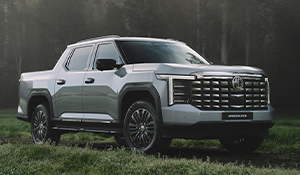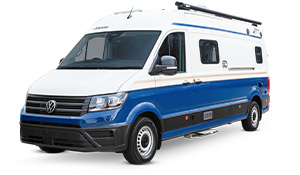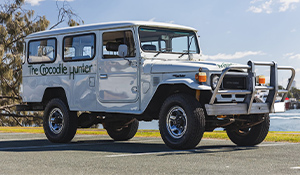FEATURE – 2021 Dodge Durango SRT Hellcat
Words: Mike Ryan
Photos: FCA
When you absolutely, positively have to get the kids to school before anyone else, the Dodge Durango SRT Hellcat is the vehicle to do it in.
Following the Charger sedan and Challenger coupe, the Durango is the third member of Dodge’s North American lineup to receive the 6.2-litre Hemi ‘Hellcat’ V8. Stick this supercharged, high-performance engine in a seven-seat SUV and the result is 0-97km/h in 3.5 seconds, a quarter mile time of 11.5 seconds and a top speed of 290km/h.

Biggest Brother
The SRT Hellcat tops the MY21 Durango family that includes the SXT, GT, R/T, Citadel and SRT 392 model grades.
While it was never offered in Australia during Dodge’s brief local resurgence a decade ago, the Durango has been around in North America for more than 20 years, initially released for the 1998 model year as a midsize SUV, based on the Dakota pickup truck and using body-on-frame construction. The second-generation version from 2004 was longer, wider and taller, leading it to be labelled as a full-size model in US terms. With the introduction of the third and current generation Durango for the 2011 model year (after a one-year hiatus for the nameplate following the demise of the Gen 2 version in 2009), the SUV reverted back to mid-size status and had switched to unitary construction, sharing many mechanical and some chassis parts with the Jeep Grand Cherokee.

Performance versions have been part of the Durango story since soon after its launch, with an R/T (Road & Track) version first offered in 2000 and similar variants following, including the SRT 392 version, powered by a 6.4-litre Hemi V8, that was introduced for the 2018 model year.
That being said, no Durango with a fire-breathing tyre-frying supercharged Hemi has been available – until now.

Max Power
Dodge teased the release of a Hellcat-powered version of their large SUV earlier this year, but only made it official in July. In unveiling the ‘Durango SRT Hellcat’, Dodge billed it as the “most powerful SUV ever”. Thanks to some tweaks to the proven Hemi Hellcat V8, it lives up to that billing, with 529kW and 875Nm maximums that exceed the likes of the Lamborghini Urus, Porsche Cayenne Turbo, Alfa Romeo Stelvio, BMW’s most potent X models and any hot Audi SUV you care to mention. The listed 529kW (710hp) maximum power at 6,100rpm even exceeds the output of its closest sibling, the Jeep Grand Cherokee Trackhawk, which uses the same engine but tops out at “only” 527kW (707hp).

The twin-screw supercharger on the Hellcat engine is of 2.3-litre capacity and spins up to 14,600rpm, with boost pressure regulated to 11.6psi. Engineers at FCA’s SRT (Street & Racing Technology) division created a dedicated cooling circuit for the charged air coolers that’s integrated into the supercharger housing itself and designed to keep incoming air cool, regardless of engine temperature.
The supercharger sits atop a cast iron engine block and heat-treated alloy heads, with performance parts including a forged steel crankshaft with specially-tuned damper, high-strength pistons with cooling oil jets and sodium-filled exhaust valves.

Complementing the engine is an SRT exhaust system that delivers the requisite growl you’d expect from a supercharged V8. There’s Launch Control, too, along with the Launch Assist system that acts to minimise wheel hop on hard acceleration.
The transmission is FCA’s proven Torqueflite eight-speed automatic, offering paddle shift controls and no less than seven different drive modes – Auto, Sport, Track, Snow, Tow, Eco and Valet. There’s selectable steering tuning, too, so manoeuvring is as easy on the track as it is in the car park.

For all its engine and transmission changes, the Durango’s all-wheel drive system rates no mention in the information released by Dodge so far, but presumably has been modified in line with other changes to complement the increased power and torque of the Hemi Hellcat V8. The system itself is rear-wheel biased, but does have a two-speed transfer case, although in this instance, low range is more about manoeuvring large boats and caravans rather than any sort of off-road work.
Pirelli Scorpion Zero tyres on 20x10 wheels are standard, while a Brembo braking package is employed to bring the SRT Hellcat to a stop. The combination of 400m front discs with 6-piston calipers and 350mm rear discs with 4-pistion calipers is capable of hauling up the (estimated) 2,550kg weight of the seven-seat SUV in 35.3 metres from 97km/h.

SRT Style and Spec
The entire Durango lineup has a more aggressive look for 2021, but to maximise its performance, the SRT Hellcat gets a number of styling and aerodynamic tweaks over the stock Durango.
Some of these are shared with the slightly less potent Durango SRT 392 and include a bonnet with heat extraction vents and a large scoop to feed air to the engine oil cooler. On the SRT Hellcat, this scoop has been upgraded for improved cold air induction. Both SRT models get a new front fascia, too, while a two-piece front splitter is exclusive to the SRT Hellcat.

At the rear, a tailgate-mounted spoiler is also unique to the SRT Hellcat and, working with the upgraded front end aero, increases rear downforce by a claimed 400 per cent - but you have to be travelling at the SUV’s top speed to achieve that! Further aiding the SRT Helllcat’s aerodynamic performance is deletion of the roof rails that are standard on other Durango models.
A wider grille pattern is another SRT Hellcat feature, along with deleted front fog lamps to allow more air into the engine bay. Cosmetic touches include black mirror caps, 20x10 ‘mid-gloss’ black alloys with machined faces, Hellcat badges on the front guards and optional twin racing stripes.

Changes under the skin include tuning of the independent suspension system that is said to improve ride comfort in Auto mode without compromising handling in Track mode. Rear shock mounts are 18 per cent stiffer, with a 20 per cent increase in rebound control. For better, flatter cornering, understeer has been reduced by 2.5 per cent and body roll is down by 5 per cent.
Finally, the Durango’s best-in-class maximum towing capacity of 3946kg (braked) is unaffected by all the SRT Hellcat’s performance upgrades.

Sports Interior
Inside, the Durango SRT Hellcat gets the redesign of the dash, instrument display and centre console that’s been applied to the rest of the MY21 Durango range.
A driver-centric approach includes tilting the centre console touchscreen towards the driver. In the case of the SRT Hellcat, this is a 10.1-inch display (the largest available in a Durango) that’s hooked up to the newer, faster and easier to use FCA Uconnect 5 infotainment system. On both the SRT 392 and SRT Hellcat, the start-up screen features a special animation intro. Dodge says there’s some easter eggs in the Uconnect 5 set-up on SRT models, too.

SRT Performance Pages information is standard, providing vehicle info and lap time displays, as well as engine and g-force readings, on the 10.1-inch screen. Race options on this system allow for adjustment of rpm and shift light settings related to the Launch Control system.
Under the screen is a new set of switchgear for the cabin comfort controls that are said to be easier to use, with the Torqueflite’s shifter redesigned for the same purpose.

The flat-bottomed sports steering wheel features a red backlit SRT logo, with the gauges adding red accents, too: both SRT Hellcat exclusives. Front seats feature heated and ventilated Nappa leather and suede trim, with an embroidered SRT Hellcat logo on the front seat uprights. Choose the optional Laguna leather interior with ‘Demonic Red’ seat facings and that logo is embossed.
‘Forged carbon fibre’ trim features throughout the cabin, while storage space has been improved and a wireless charger added. Apple CarPlay and Android Auto compatibility is standard on all Durango models.
The Uconnect 5 system offers over-the-air software updates and a 4G Wi-Fi hotspot, while remembering that the SRT Hellcat is a family hauler, a second-row Blu-ray entertainment system is optional, adding 9.0-inch screens to the front seatbacks.

Limited Release
While the Durango SRT Hellcat will not be a numbered limited edition, its availability will be restricted. A cap on production hasn’t been officially announced, but it will be an exclusive model – less than 2,000 units for the North American market, according to unconfirmed reports. Also limiting its market will be price. At around US$82,000, the SRT Hellcat carries a premium of 27 per cent over the SRT 392 grade with AWD and is more than two and a half times the price of the base RWD-only V6 Durango.

Tighter emissions regulations, which come into effect in the US from 2022, mean the Durango SRT Hellcat will only be offered for the 2021 model year, although some overseas reports suggest Dodge are already working on a similar – but perhaps not as potent – model for the future.
The other limiting factor and the “wrong” thing mentioned at the top of this article is that the Durango SRT Hellcat will only be offered in North America. Unlike the Jeep Grand Cherokee Trackhawk with which it shares most of its running gear and some of its chassis componentry, the Durango is not built in RHD, so there is no likelihood of an official Australian release.
American Special Vehicles (ASV), who undertake the importation and conversion of RAM trucks for the Australian market, has been mentioned as a possible conduit to deliver Durangos locally, but with booming RAM truck sales, ASV have got their hands full at the moment. Also, converting a Durango would come with greater cost and complexity - and potentially less profitability - than the RAM trucks in Australia’s crowded and competitive SUV market. That leaves it up to other specialist conversion companies and individuals to take on the job.
If you’re enterprising enough and have the right contacts in the US, you may be able to get hold of a Durango SRT Hellcat when they go on sale early next year and bring it here for conversion. But with high demand in the home of the muscle car, muscle truck and muscle SUV, getting one out of the US will be the problem…









